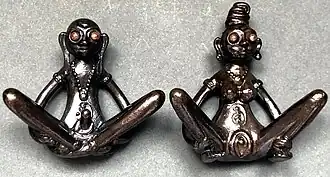Ngang

The Ngang (งั่ง), also known as Phra E-Hang (พระอีหง่าง) in the Isan and Lao dialects, is a Khmer-style amulet venerated in northeastern Thailand and southern Laos. It is believed to bring metta mahaniyom (loving-kindness and popularity), success in business, personal charm, and even invulnerability to its wearer.[1] Today, Ngang amulets are widely collected, ranging in value from a few baht to hundreds of thousands.[2]
Belief in the Ngang dates back to the Ayutthaya Kingdom.[3] According to folklore, a man who was heartbroken planned to become a monk. During his ordination, however, his former lover returned to reconcile. He abandoned the ordination, but a strange event followed—many women became enamored with him. He became known as “Ngang,” a name that implies being consumed by lust rather than religious devotion. Occult practitioners later crafted amulets in his likeness, believed to possess seductive power.[4]
Some believe the Ngang represents Phra Thusil.[5] However, Phra Khru Thammawongsa, abbot of Wat Chom Phet in Champasak Province, Laos, explained that in Lao, Ngang is an honorific used before the names of characters with supernatural power, such as Ngang Si Hong, Ngang Sang Thong, or Ngang Sin Sai.[6] Research by Thanong Wongputt et al. (2016) notes that amulets such as the Palad Khik, Pho Ngat, and Ngang belong to a shared group associated with the Hindu god Shiva, rooted in Brahmanical traditions.[6]
Ngang amulets are typically designed with bare-chested figures in meditative poses. The hair tilts to the right, with a grinning or fierce expression. Many have red eyes made from artificial gems or stones.[1][5]
A related amulet, Pho Ngat, depicts a figure sitting with raised knees and holding the penis. The female version, Po, shows a naked woman sitting with legs spread, exposing the vagina.[7] Another variant, known as In, depicts a male and female in an erotic embrace.[8]
Because the Ngang is associated with attraction and fertility, it is traditionally worn at the waist near the genitals. Worship rituals often involve offerings connected to femininity, such as items associated with the menstrual cycle.[4] It is also believed that if the wearer does not bathe or engages in impure behavior, the amulet's power increases, as the Ngang is said to resonate with impurity.[1]
A ceremonial feast for the Ngang is held annually on Songkran Day (April 15), involving boiled chicken, boiled eggs, rice, water, and white liquor. To test the authenticity of a Ngang, folklore suggests placing it face down and having a woman jump over it or wave her sarong—if the amulet turns to face her, it is real.[1][9] If it mysteriously disappears, it is said to reappear in a woman's underwear or pants, which is considered a normal occurrence.[9]
See also
References
- ^ a b c d เด็กป้าผักลีด (3 November 2022). ""Ngang" amulet with powerful charm And the origin of the insult "idiot"". ศิลป์สัมพันธ์. Retrieved 29 January 2023.
- ^ Cite error: The named reference
สนุกwas invoked but never defined (see the help page). - ^ Cite error: The named reference
ศิลป์สัมพันธ์was invoked but never defined (see the help page). - ^ a b Thanong Wongputt; et al. (January–June 2016). Common belief in amulets in the Thai-Laos-Cambodian border town. Ubon Ratchathani University Journal 12:1 (2016). p. 316.
{{cite book}}: CS1 maint: year (link) - ^ a b Karaket Sriparinyasilpa (3 November 2022). "Red-Eyed Ngang Amulet, Worldly Power?". Sanook.com. Retrieved 29 January 2023.
- ^ a b Thanong Wongputt; et al. (January–June 2016). Shared Beliefs in Amulets in the Thai-Lao-Cambodian Border Town. Ubon Ratchathani University Journal 12:1 (2016). p. 317.
{{cite book}}: CS1 maint: year (link) - ^ Thanong Wongputth; et al. (January–June 2016). Shared beliefs about amulets in border towns Thai-Laos-Cambodia. Ubon Ratchathani University Journal 12:1 (2016). p. 315.
{{cite book}}: CS1 maint: year (link) - ^ Thanong Wongputth; et al. (January–June 2016). Shared beliefs about amulets in border towns Thai-Lao-Cambodia. Ubon Ratchathani University Journal 12:1 (2016). p. 318.
{{cite book}}: CS1 maint: year (link) - ^ a b Cite error: The named reference
Funwas invoked but never defined (see the help page).